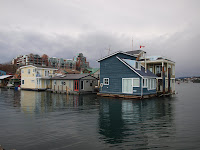
We decided to drive around the harbour to have breakfast at a marina I remembered from last time we were here. I remembered a sheltered harbour with houseboats, and a house that was covered in all sorts of marine paraphernalia. By following my nose, which must have been how we found it last time, we finally turned a corner and the harbour opened up in front of us. Taking another turn towards the water we saw the "Shell House", and it brought back memories for the kids. We stopped and wandered

around the house taking photos, and then headed across to the restaurant on the harbour for breakfast. Inside there was all sorts of maritime photos and real stuffed fish, trophies of past expeditions. It was a nice breakfast as we looked out over the houseboats and the harbour wondering whether it was going to rain again, or snow. Luckily it cleared for us to walk around the marina, but it was still quite cold.

When Bridget came over with her school acouple of weeks ago, they went to Parliament, the Royal BC Museum, and Craigdarroch Castle. She had said it would be a good place to have a look at, so we headed for the castle before heading north. It was situsted a few kms away from the city centre on the top of a hill that would have afforded a great view in all directions - towards the city, ocean and mountains. The view is still good, but there are lots of buildings and roofs in view.
Craigdarroch Castle is a beautiful historic Victorian-era mansion, built in the 1890s by wealthy BC coal baron Robert Dunsmuir.
Rising 87 stairs up through the 4 1/2 stories, there are 39 rooms, most of which are furnished lavishly in the 1890s–1900s period. With over 20,000 square feet of space, the house and gardens are being restored exactly as they were originally built. It is an amazing building and wood features throughout the castle. The tender to build the castle was won by a Chicago firm. They prefabricated the building and shipped it in 5 railcars across the continent. RObert Dunsmuir never saw the completed castle. He died just months before it was completed, but his wife went on to live there for another 18 years. It was worth the visit.
We then headed north towards Chemainus.

It was a town that relied heavily upon the wood and forestry industry. In 1983 the sawmill closed and 700 people out of a population of 400 lost their jobs. They decided to beautify the place and painted murals all around town. It is now world famous for it's murals. Take the mural tour
here. It now relies heavily on tourism and has hundreds of thousands of people visiting each year. We spent a couple of hours wandering around before again continuing up the island.
To get to Quadra Island we had to first travel to Campbell River, and then get a ferry. By the time we got to Campbell River it was getting dark and everyone was hungry, so we stopped at a White Spot for a meal. We then got some groceries before taking the 9:30 pm ferry across the passage. This is a 1 1/2 km stretch of water that seperates Quadra from the mainland. It is also a stretch of water that all the cruise ships and liners use to cruise the Discovery and Inside Passage tours. The ferry crossing only took about 15 minutes. We then found our way in the dark to our accomodation. The ESL teacher at Kerrie's school had said that her parents-in-law had a place that had just been built up on Quadra, and made arrangements for us to stay there while they were visi

ting in Vancouver. We have never met, but may catch up with them later in the year. It was extremely kind of them, and we planned to stay for two nights.
Quadra Island is the largest of the Discovery Islands. We explored the island the next day heading north for a
walk out to Bold Point. Travelling south we went to Herriot Bay, and then down to Cape Mudge
home to the We Wai Kai band of the Laichwiltach People, part of the Kwakwak'awakw First Nation, and the lighthouse. We headed back to the Herriot Bay Inn for dinner.

































